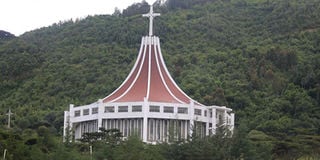Subukia shrine draws pilgrims from all faiths

The Subukia Catholic shrine in Nakuru Town. Cardinal Maurice Otunga officially opened the shrine in 1984. PHOTO | JOSEPH OPENDA | NATION MEDIA GROUP
What you need to know:
- It dates back to 1980, when Pope John Paul II tasked the Kenya Conference of Catholic Bishops to come up with a national prayer site.
- The first weekend of October is the national prayer day, when pilgrims, led by Catholic priests, gather at the venue.
About 40 kilometres from Nakuru Town, on the Nakuru-Nyahururu road, is the Subukia Catholic Shrine, which attracts people from all faiths.
The shrine sits atop the Subukia Hills on a 200-acre tract, about five kilometres from the highway, and is visited by pilgrims from different parts of the country.
It dates back to 1980, when Pope John Paul II tasked the Kenya Conference of Catholic Bishops to come up with a national prayer site.
Cardinal Maurice Otunga officially opened the shrine in 1984, and pilgrims began flocking the venue, regarded as holy by believers from different denominations.
The pilgrims, Christians and non-Christians, visit the shrine for spiritual guidance and counselling, confession or to offer special prayers.
The shrine comprises several features: a cross, church, spring and bookshop. Each item is of significance to Catholics.
CONFESSION
Several Catholic priests from the Conventual Franciscan Friars order are always on hand to welcome, guide and bless visitors who do not understand what confession entails.
Father Eric Mochianto, who was on duty when we arrived, said the shrine has seven priests dedicated to serving pilgrims.
He said the priests’ responsibilities are to lead Mass and guide pilgrims through confession and the Way of Christ.
The confession begins at a monumental structure known as “the Way of the Light”, where meditation starts as pilgrims begin walking along a path leading to a big cross on top of a hill.
They then proceed to the grotto, a small chapel dedicated to Mary, the Mother of Jesus, where Catholics offer intercessory prayers.
They also recite the rosary as they climb the hill. The climbing, we are told, symbolises the suffering of Jesus as he carried his cross on the way to his crucifixion site. On top of the hill is a spring.
'SPECIAL' WATER
It was discovered in 1992 and its waters are believed to have healing powers.
Some pilgrims come with jerrycans to fetch some of the water to take back home.
They believe sprinkling it around their homes brings them God’s blessings. Meanwhile, others drink the water so that they can be healed from various diseases.
The shrine is always busy, with its calendar full throughout the year. But Father Mochianto pointed out that certain special arrangements exist for different groups to visit the site.
For instance, women from all parts of the country meet for prayers in February while men meet in the first week of May.
The first weekend of October is the national prayer day, when pilgrims, led by the Catholic priests, gather at the venue.
RETREAT
Meanwhile, the youth meet on the first weekend of December for guidance and counselling.
There is also a retreat house where those who want to spend more time at the shrine and need accommodation can stay.
The shrine has become a popular site for family retreats and believers seeking personal time for meditation away from the hustle and bustle of urban centres.
Is there a site you want us to feature? Write an e-mail to [email protected]





